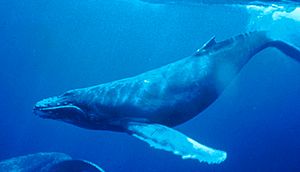Sonar facts for kids
Sonar is a special machine that uses sound waves to find objects underwater. Think of it like a pair of ears and a voice for the ocean!
There are two main types of sonar:
- Active sonar sends out sound waves. Then, it listens for the sound waves to bounce back, like an echo. This helps it find objects.
- Passive sonar doesn't send out sound. Instead, it just listens for sounds made by objects in the water.
For active sonar to work, it needs two main parts:
- A transmitter that creates the sound waves.
- A hydrophone that listens for the sound waves and turns them into electrical signals.
The idea of using sound underwater is very old. In 1490, Leonardo da Vinci used a tube in the water to listen for ships. The first active sonar was used in 1917 by Paul Langevin. The word SONAR was made during World War II and stands for Sound Navigation and Ranging.
Contents
How Sonar Was Developed
Even though animals like dolphins and bats have used sound to find things for millions of years, humans started using it in the water much later. As mentioned, Leonardo da Vinci was one of the first in 1490. He used a tube to listen for ships.
Later, in the late 1800s, underwater bells were used near lighthouses. These bells helped warn ships about dangers.
The idea of using sound to "echo-locate" underwater, like bats do in the air, became very important after the RMS Titanic sank in 1912. A month after the Titanic disaster, a British scientist named Lewis Fry Richardson filed the first patent for an underwater echo-ranging device. A German physicist, Alexander Behm, got a patent for a similar device in 1913.
A Canadian engineer named Reginald Fessenden also worked on an experimental sonar system. In 1914, he tested it on a ship called the Miami. He showed that it could measure depth, send messages underwater, and even find an iceberg from far away!
During World War I, finding submarines became very important. This led to more research into using sound. The British used listening devices called hydrophones. The French physicist Paul Langevin worked on active sound devices to find submarines in 1915. Their work helped create the sonar systems we have today.
How Sonar Affects Ocean Life
Sonar can be very useful for humans, but it can also affect animals living in the ocean.
Impact on Marine Mammals
Studies have shown that active sonar can sometimes cause marine mammals, like whales and dolphins, to swim to shore in large groups. This is called a mass stranding. Beaked whales are especially sensitive to certain types of sonar.
Other whales, like the blue whale, also try to get away from sonar sounds. Some research suggests that naval activities, which use sonar, might be a reason for some dolphin strandings.
The US Navy, which helped fund some studies, said that the findings only showed how animals reacted to sonar, not that they were actually harmed. However, they said they would look at how well their protective measures for marine mammals work. A US Supreme Court ruling in 2008 noted that there was no clear proof that sonar had harmed or killed a marine mammal.
Some marine animals, like whales and dolphins, use their own natural sonar, called biosonar, to find food and avoid danger. Research on blue whales shows that mid-frequency sonar can stop them from feeding. This means sonar could affect how whales find food and stay healthy.
A review in 2019 looked at why beaked whales strand when naval exercises use sonar. It found that sonar affects Cuvier's beaked whales the most, but it can be different for each whale. The review suggested that whales might react differently based on whether they have heard sonar before. It also noted that stranded whales sometimes show signs of decompression sickness, which might be caused by their reaction to sonar.
In the Canary Islands, where many strandings used to happen, no more mass strandings occurred after naval exercises using sonar were banned. Scientists suggested that this ban should be used in other areas where strandings still happen.
Impact on Fish
Very loud sonar sounds can temporarily affect the hearing of some fish. This means they might not hear as well for a short time.
Images for kids
-
Sonar image of the Soviet Navy minesweeper T-297, formerly the Latvian Virsaitis, which was shipwrecked on 3 December 1941 in the Gulf of Finland
-
AN/AQS-13 Dipping sonar deployed from an H-3 Sea King
See also
 In Spanish: Sonar para niños
In Spanish: Sonar para niños














